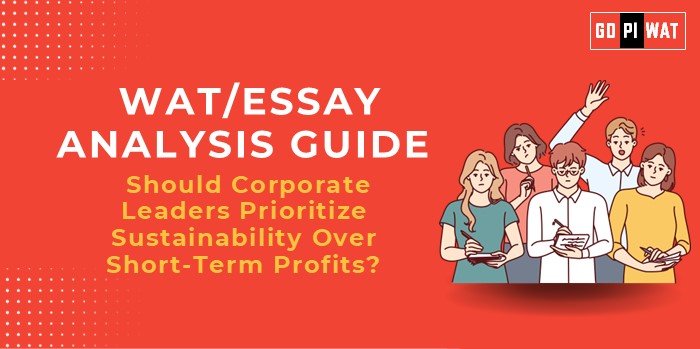📋 Should Corporate Leaders Prioritize Sustainability Over Short-Term Profits?
🌐 Understanding the Topic’s Importance
Businesses today face mounting pressure to address climate change, social inequality, and resource depletion while maintaining profitability. Sustainability is increasingly recognized as a key driver for long-term success, stakeholder trust, and innovation, making this topic critical for corporate strategy and leadership.
📝 Effective Planning and Writing
- ⏳ Time Allocation: Planning: 5 mins | Writing: 20 mins | Review: 5 mins.
- 📚 Structure:
- Introduction: 60-70 words
- Body Paragraphs: 350-375 words (Achievements, Challenges, Future Outlook)
- Conclusion: 60-70 words
💡 Introduction Techniques for Essays
- 🔄 Contrast Approach: “While companies prioritizing short-term profits may benefit immediately, neglecting sustainability can result in regulatory penalties, reputational loss, and long-term financial risks.”
- 🔧 Solution-Based Start: “The solution to balancing short-term profits with sustainability lies in strategic investments, innovative technology, and phased implementation, ensuring profitability today and resilience tomorrow.”
📊 Structuring the Essay Body
🏆 Paragraph 1: Achievements
- 📈 Topic Sentence: “Sustainability offers long-term profitability and operational efficiency.”
- 💡 Example: Unilever reported a 20% higher revenue growth from its sustainable brands.
- 🌍 Impact: Builds stakeholder trust, mitigates financial risks, and reduces operational costs.
⚠️ Paragraph 2: Challenges
- 📊 Topic Sentence: “Short-term financial pressures and high costs often hinder sustainable transitions.”
- 💰 Data: Transitioning to green energy can cost companies millions upfront.
- 🔍 Example: BP’s pivot to renewables faced initial profitability challenges.
🔮 Paragraph 3: Future Outlook
- 📌 Topic Sentence: “Balancing both priorities requires innovation and phased planning.”
- 🌟 Example: Companies adopting ESG frameworks outperform their peers by 25% (Harvard Business Review).
- 📝 Recommendation: Access to green finance, regulatory incentives, and sustainable innovation.
📄 Concluding Effectively
- ⚖️ Balanced Perspective: “Corporate leaders must prioritize sustainability while ensuring financial viability, as a phased approach can secure long-term growth and resilience.”
- 🌍 Global Comparison: “Countries like Sweden prove that sustainability and economic success can coexist, offering a model for global corporations to emulate.”
📚 Sample Short Essays
⚖️ Balanced Perspective
Corporate leaders must strike a delicate balance between short-term financial goals and long-term sustainability. Companies prioritizing ESG practices demonstrate resilience and profitability, while those neglecting sustainability risk financial and reputational losses.
🔍 Solution-Oriented
Investing in sustainability is not just ethical—it’s strategic. By adopting green technology and efficient practices, companies can reduce costs, drive innovation, and secure long-term profits.
🌍 Global Comparison
Countries like Sweden and companies like Unilever showcase that sustainability drives economic success. By integrating ESG goals, corporate leaders can ensure profitability while addressing global challenges.
🔑 Recommendations for Sustainable Progress
- 📋 Phased Implementation: Gradually integrate sustainability to reduce financial strain.
- 📘 Incentivizing ESG Goals: Governments should promote green financing and provide tax benefits.


